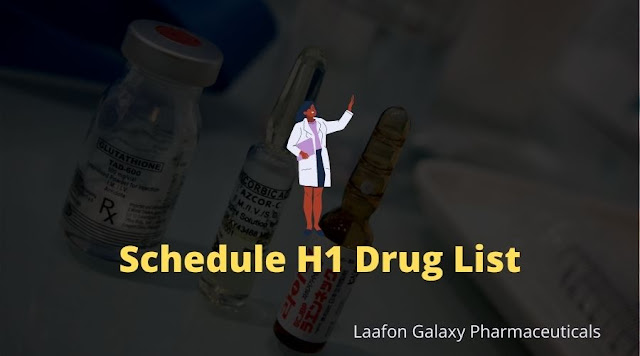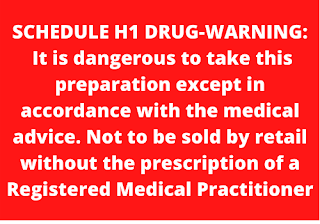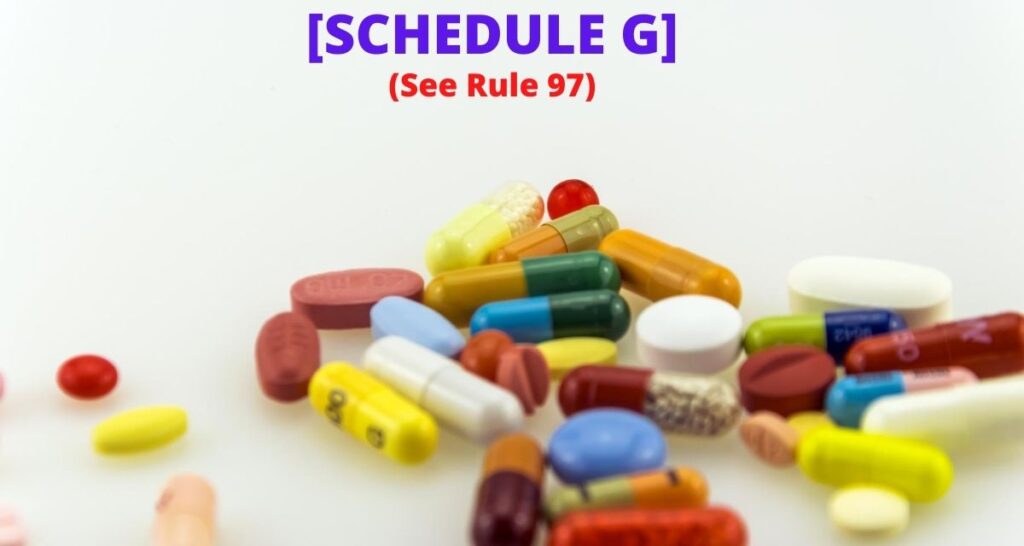Overview
In 2014, the Govt. of India introduced a new Schedule of prescription drugs to control the misuse of prescription drugs, which is called Schedule H1 Drug List. It contains medications that contain Opioids, Sedatives molecules, stimulants, and substances that are known to be addictive and have the potential for abuse. [Site Link1]
In short, the Schedule H1 Drug List is a compendium of medicines that are understood as critical to public health if taken as a self-medication. Schedule H1 Drug list is a vital tool in the regulation and monitoring of drugs in India. This list is distinct from the Schedule H and Schedule X drug lists, as it includes medicines that fall under the purview of the NDPS Act, 1985, and strong antibiotics like the cephalosporins group’s molecules.
These drugs are considered to have stricter regulations and controls compared to Schedule H prescription drugs.
H1 Drug List Formation
Medicines covered in the Schedule H1 classification can only be sold by a registered medical practitioner with a valid prescription slip of a registered medical doctor or practitioner. The prescription format should be in a specific manner, that must contain the Name, Address, Name of Medicine, Dosage of medicine, and duration of the course.
The Government of India excluded 40 drugs from Schedule H. These excluded drugs are included in the Schedule H1 drug list which was newly formatted in 2013. In this regard The Drug Controller General of India issued a notification which was based on the recommendations tabled by the Drug Technical Advisory Board of India (DTAB), this is notable that DTAB is a technical advisory division of the Central Drugs Standard Control Organization.

According to the notification issued for the Schedule H1 drug list, the product that will have any ingredient from the Schedule H1 drug list will have to carry a Warning: “SCHEDULE H1 DRUG-WARNING: It is dangerous to take this preparation except in accordance with the medical advice. Not to be sold by retail without the prescription of a Registered Medical Practitioner.” As per the new rule, it is mandatory for chemists and druggists to maintain the sales register of medicines that contain any Schedule H1 Drugs in their composition. The warning should be in a box with a red line border and the base of the warning should be red.
ALSO READ: Schedule x DRUG LIST
Schedule H1 drug Warning

Schedule H1 drug List
The drugs included in schedule H1 drugs by the Government Of India and Central Drugs Standard Control Organization are listed below:
- Alprazolam
- Balofloxacin
- Buprenorphine
- Capreomycin
- Cefdinir
- Cefditoren
- Cefepime
- Cefetamet
- Cefixime
- Cefoperazone
- Cefotaxime
- Cefpirome
- Cefpodoxime
- Ceftazidime
- Ceftibuten
- Ceftizoxime
- Ceftriaxone
- Chlordiazepoxide
- Clofazimine
- Codeine
- Cycloserine
- Diazepam
- Diphenoxylate
- Doripenem
- Ertapenem
- Ethambutol Hydrochloride
- Ethionamide
- Feropenem
- Gemifloxacin
- Imipenem
- Isoniazid
- Levofloxacin
- Meropenem
- Midazolam
- Moxifloxacin
- Nitrazepam
- Pentazocine
- Prulifloxacin
- Pyrazinamide
- Rifabutin
- Rifampicin
- Sodium Para-aminosalicylate
- Sparfloxacin
- Thiacetazone
- Tramadol Hydrochloride
- Zolpidem
Penalties for Disobeying Schedule H1 Drug Regulations
The penalty for disobeying the Schedule H1 drug regulation may vary as per the severity of the offense, and the jurisdiction where the offense happened.
According to the Drugs and Cosmetics Act of 1940, manufacturing, sale, distribution, or possession of medicines that are covered in Schedule H1 prescription drugs without a valid license is considered a criminal offense that can imprisonment for the maximum term “Three years” or a fine up to Rs. 10000. (Ten Thousand)
If a person is found guilty of importing, exporting, or attempting to export Schedule H1 drugs can face jail for a term of up to “Ten Years”, and or a fine of up to Rs. 100000/- (one lakh)
A Healthcare Professional, Medical shop owner, or distributor who violates the regulations of Schedule H1 Drugs can face the suspension or revocation of his sale license and all the above criminal penalties.
The penalties for Schedule H1 Drug offenses may differ depending on the violation of law for a specific drug, for example, penalties for Cefixime are not similar to penalties for Codiene and Tramadol misuse.
Also Read: What is Aduhelm aducanumab drug? | Side effects, Cost, and benefits of Aducanumab
Misuse of Schedule H1 Drugs
When someone disobeys the regulations of the Drugs and Cosmetics Act 1940 made for Schedule H1 drugs that is termed as Misuse of Schedule H1 Drugs. These drugs have the potential for addiction to someone and abuse, Therefore, these medicines are highly regulated and controlled by Govt. through law.
Misuse of these drugs can lead to lots of negative effects on the patient including physical, and psychological dependence on these drugs. The patient can die if a takes an overdose on these drugs.
The most common Schedule H1 drugs are Codiene, Alprazolam, and Tramadol hydrochloride which are the maximum cases of misuse found.
Examples of Misuse of H1 Drugs
Some Schedule H1 drugs like Tramadol Hydrochloride were used in Punjab, Rajasthan, and Haryana by youth for sedative purposes. There were many cases registered against the drug trafficking people in Punjab for Tramadol misuse. The government of Punjab and Rajasthan urged to Govt. of India to include this drug in the controlled drugs in India. Therefore, in 2013 vide a gazette notification no. SR-No.-588E-Dt-30-08-2013 by CDSCO.
H1 Drugs Indications
Drugs included in the Schedule H1 drugs list are different in category and specifications. Some of them are fourth-generation antibiotics like Cefixime, Cefpodoxime, Ceftriaxone, Cefoperazone, and Cefdinir, etc. It also contains anti-TB drugs like Isoniazid, Rifabutin, and Rifampicin. Therefore, Indications of Schedule H1 drugs are totally different from each other.
Side effects of H1 drugs
Schedule H1 Drugs list contains more than 40 medicines. Each drug has its own uses and side effects. Therefore, it is not practical to demonstrate the side effects of H1 drugs list collectively, however, there are some common side effects of most of the drugs which are listed below:
- Dizziness
- Headache
- Nausea
- Abdominal pain
- Vomiting
- Diarrhea
- Malaise
- Heartburn
Dosage of Schedule H1 Drugs
Medicines covered in Schedule H1 drugs are stronger than in Schedule H drugs so it is strongly recommended that you should never use these drugs without the prescription of a registered medical practitioner. To know about the dosage of these drugs you should consult the Doctor. It may have serious implications on your health if you take self-medication from the H1 drugs list.
Schedule H1 Drugs Sale and Purchase Record Format:
According to the Drugs and Cosmetic Act, every Healthcare professional, retailer, or wholesaler has to maintain a sale and purchase record for the drugs covered in the Schedule H1 drugs list. The record should be clear and free from any overwriting. The record needs to be in ledger format so that can easily be tallied at the time of any inspection by drug authorities. The sale record must contain the Name, Address of the patient, Name of Medicines, Duration of treatment, and photocopy of the prescription slip of the Registered Medical Practitioner. A sample format is provided below to take some insights for maintaining the record:
SCHEDULE H1 DRUGS SALE PURCHASE RECORD FORMAT
| DATE | PRODUCT NAME | PURCHASE QTY. | SALE QTY | BALANCE QTY. | PATIENT’S NAME AND MOBILE NO/ Address. |
| 01.01.2020 | ZIFI-200 | 10 STRIPS | 1 STRIP | 9 STRIPS | RAVI 9999999988 |
Precaution and Warning
Schedule H1 drugs list is the classification of highly monitored and controlled medicines that require a high level of supervision while using on a patient. These drugs are top-level antibiotics that are used against special types of bacteria that can not be judged without medical investigation. Therefore, taking medicine without consulting a doctor may be harmful. Some medicines have the potency of addiction and abuse(Tramadol) in some patients, these drugs are not recommended as self-medication. We strongly recommend following the instructions of a health professional before taking these medicines.
Summary
The main objective of Govt of India is to curb the unnecessary use of antibiotics which leads to antibiotic resistance in citizens of the country. There are lots of incidences of antibiotic resistance including the emergence of MRSA, MDR-TB, and XDR-TB, due to irrational drug use. The sale of medicines covered in the Schedule H1 drug list will be controlled and monitored effectively by Govt officials. Schedule H1 Drug list is a highly regulated prescription drug in India that should not be misused, if someone is found disobeying the regulations made for Schedule H1 drugs he can face imprisonment and a fine of up to one lakh.
Related Posts:
- Working principle of HVAC system
- SCHEDULE G DRUG LIST
- Pharmaceutical formulation plants for sale in North India
References:
- Drugs and Cosmetic Act 1940, 21st Edition By Vijay Malik
- Central Drugs Standard Control Organization [LINK]
- World Health Organization (WHO) – Essential Medicines and Health Products (https://www.who.int/medicines/services/inn/en/)
- Indian Pharmacopoeia Commission (https://ipc.gov.in/)
- National Center for Biotechnology Information (NCBI) – PubMed (https://pubmed.ncbi.nlm.nih.gov/)
- Pharmacology and Pharmacotherapeutics” by R. S. Satoskar, Nirmala N. Rege, and S. D. Bhandarkar
Disclosure:
As a pharmaceutical professional involved in manufacturing different types of medicines including tablets, capsules, Liquid orals, and Injections. I do not have any personal interests or conflicts of interest. However, it is possible that the information consumed by me as a reference for this post is based on the available scientific research and publication in the public domain and on the internet. There are possibilities of being the information biased by some pharmaceutical companies who funded the studies. Therefore, it is important to critically evaluate the source of information.
I have assessed and reviewed several studies from reputed sources and websites to support the authenticity of the information provided. The sources were selected on the basis of the relevancy and authority of the websites in the niche. If you require additional information, please let me know by leaving a comment and I will do my best to provide it to you.

